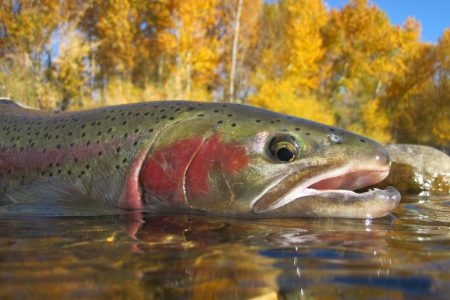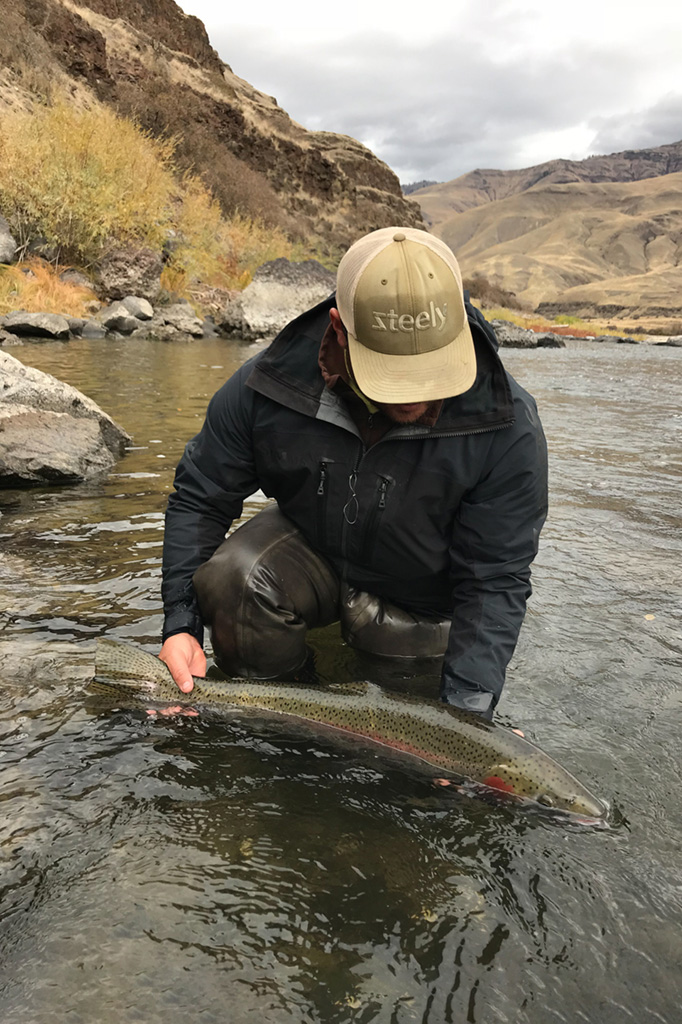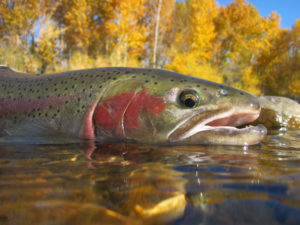While the plight of wild salmon is often the subject of great debate and policy fights, the challenges Salmon River steelhead face are less well known, though equally formidable.
Salmon River steelhead—which are an anadromous type of trout—embody the geographical diversity and untamed wildness of the Pacific Northwest. As an anadromous fish, defined by their ability to occupy freshwater and saltwater habitats, steelhead begin their journey as fry, measuring roughly one inch in length, in the upper stretches of the Salmon River. Following brief developmental growth, fry are swept downriver by the currents of the Salmon River, ushered through the Snake, then Columbia River basins, and then into the Pacific Ocean.
If they survive, the adventurous and formidable fry reside in the saltwater ecosystem for one to four years. The duration of their Pacific Ocean residency classifies the fish as an “A-run fish,” which spends one year in the saltwater, or “B-run” fish, which spends two years or longer in the saltwater feeding ground. Despite harsh conditions and aggressive predation, the caloric-rich chambers of the Pacific Ocean allow steelhead to grow extremely rapidly, with older fish growing to over 37 inches and 20 pounds. The Idaho state record for a caught steelhead is a 44-inch, 30-pound beast “roped” in 1973.
Following the feeding frenzy and rapid growth period, Salmon River steelhead commence their arduous expedition back to their native headwaters. In total, Salmon River steelhead travel over 900 miles and climb 7,000 feet in elevation. The journey ranks as the longest and steepest steelhead run in the country. These “pioneers” have made this exact migratory voyage for over a
millennium.
However, as the Northwest river systems have been developed and managed, these remarkable fish—like the salmon—have been depleted.
The environmental and societal factors contributing to their demise is complex. However, precipitous fish decline can be attributed to three general factors: irresponsible angler pressure,degradation of habitat, and the negative effects of the Columbia and Snake River dams.
Irresponsible angler pressure includes fishing with barbed hooks, targeting fish with snagging techniques, illegally harvesting wild steelhead (hatchery fish are only harvestable, as evidenced by a healed adipose scar), and unlawfully exceeding daily bag limits. Additionally, conscientious anglers need to implement proper fish handling skills, including keeping fish in the water and removing quarry only low to the water, and keeping them out of water no longer than a few seconds, if necessary. The use of live bait, multiple hooks, and treble hooks are additional exogenous factors diminishing steelhead populations. Finally, overplaying fish, thus “horsing” fish to exhaustion for enjoyment, is a lesser, yet still harmful practice.
As the angler effects of catch-and-release practices on steelhead have been extensively researched by wildlife biologists, numerous studies reveal that the most traumatic effect of catch-and-release fishing is caused by excessive time out of the water. The stress the fish undergo decreases the dissolved oxygen available to them and increases blood pH and lactate in their systems. No doubt the proliferation of social media and the quest for the “perfect” image have materially increased the fish’s time out of water.
From a macro-perspective, habitat degradation includes water pollution, the diminishing health of oceanic ecosystems, and lack of access to historic freshwater habitat. The impacts of climate change and increased global water temperatures are also complex but relevant factors.
 Finally, the dam systems have significantly impacted the health of Idaho’s wild steelhead runs. These fish must descend and ascend through eight dams on their journey to and from the Salmon River tributaries, including the lower four Snake River dams: Ice Harbor, Lower Monumental, Little Goose, and Lower Granite: and the four Columbia River dams: Bonneville, The Dalles, John Day and McNary.
Finally, the dam systems have significantly impacted the health of Idaho’s wild steelhead runs. These fish must descend and ascend through eight dams on their journey to and from the Salmon River tributaries, including the lower four Snake River dams: Ice Harbor, Lower Monumental, Little Goose, and Lower Granite: and the four Columbia River dams: Bonneville, The Dalles, John Day and McNary.
In navigating these dams, the steelhead fry are forced through a chute into the turbine system, which consists of five blades and a large shaft weighing over 120 tons.
This system rotates at approximately 80 revolutions per minute, creating high pressure, often injuring or killing the juvenile fish. Fish mortality occurs as fish are forced into violent contact with the blades and concrete walls or through intense water pressure that leads to exhaustion.
According to a report by the Northwest Power and Conservation Council, “Biologists estimate that if turbine passage is the only way past a dam, 10 to 15 percent of the fish that are drawn through the turbines will die. With that much mortality at least possible at each dam, fish that pass multiple dams, such as fish from central Washington or the Snake River, have a statistically high probability of dying before they pass the last dam, Bonneville.” With even a minimum 10 percent death rate at each of the eight dams, only about 20 percent of the initial run could be expected to survive them. Once past the last dam, the fry still face the challenges of dam-created hurdles: slower water velocities, altered river temperatures, and increased exposure to predators.
Given the long odds, it is somewhat miraculous that the species hangs on, albeit tenuously. The perseverance of these fish reflects the bedrock qualities of the American West: toughness, daring, and spirit. Their survival depends on these qualities, as well as on the appreciation and support of outdoor enthusiasts, fly-fishing fanatics, visitors to the waterways, and vested parents or grandparents hoping that this biological marvel can be witnessed for many Idaho generations to come.
Idaho Steelhead Harvest Regulations
- One fish per day, three fish in possession.
- Size limitations: no steelhead larger than 28 inches may be taken on the Clearwater or Snake Rivers.
- Visit the Idaho Fish and Game website (idfg.idaho.gov) for more information.



